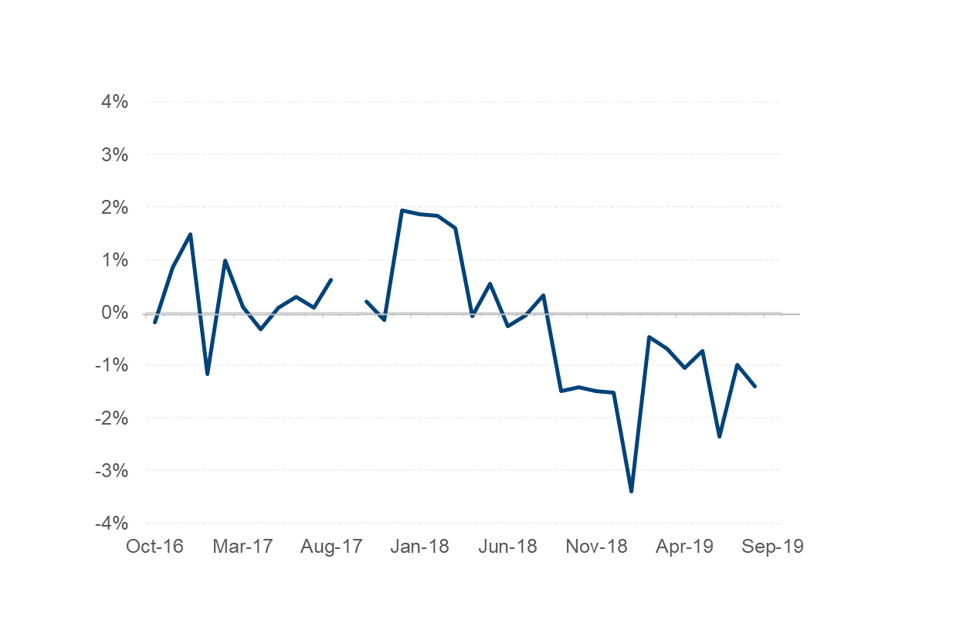Change to the People on Universal Credit employment indicator from November 2019 onwards
Published 15 October 2019
This statistical notice advises users of an intended change to the employment indicator published as part of the People on Universal Credit figures in the monthly release of Universal Credit statistics.
The People on Universal Credit figures are updated monthly. The latest month’s figures in each release are provisional and revised in the following month’s release. These statistics include a breakdown by whether the claimant is in employment or not in employment. Up to October 2019, this breakdown has been included on both the provisional and revised figures. From November 2019, we will be providing this breakdown on the revised figures only. This change is due to a review of our methodology for creating this breakdown showing it is no longer suitable to do so.
The employment indicator is calculated using completed assessment period earnings data. An individual on Universal Credit at the count date (the second Thursday of each month) will be recorded as in employment if they have employment earnings recorded within their completed Universal Credit assessment period overlapping the count date.
Due to our production timescales, not all the relevant assessment periods for those on Universal Credit on the latest count date are complete. This means that we cannot capture complete earnings information directly for all individuals in the provisional month and, as a result, the corresponding employment figure is estimated.
In line with the Office for Statistical Regulation’s Code of Practice for Statistics, we regularly re-evaluate the methodologies we use to produce our statistics. We have reviewed the suitability of our employment indicator methodology following the closure of Universal Credit live service to new claims in January 2018, and existing claims in March 2019 after the complete roll out of Universal Credit full service in December 2018.
Read more information about the differences between live and full service.
Our analysis (see figures 1 and 2) reveals that, since the closure of live service, our estimation process for the provisional employment figure has been showing poorer quality estimates. The revised and provisional figures were very similar until the end of 2017, the point where live service closed to new claims. Provisional figures were then higher than the revised figures in the first half of 2018 but have been consistently lower than the revised figures since September 2018, by 0.5 to 3.4 percentage points depending on the month.
Figure 1: Difference between the provisional and revised figures for the People on Universal Credit employment indicator, October 2016 to September 2019

Note 1: Revised figures for September 2019 are not yet available.
Note 2: This graph shows the revised and provisional figures reported at the time the data were first released for each month to allow comparison between revised and provisional data. As changes in methodology have resulted in revisions to the back series since some of these figures were originally released, the figures in this graph may not match with those currently available on Stat-Xplore.
Note 3: No figures are available for September 2017 (the gap shown on the graph) as a change in the caseload methodology at this point means that the revised and provisional figures for this month are not directly comparable.
Note 4: Figures are shown from October 2016. Prior to this point, small volumes mean that the differences between the 2 figures were more volatile.
Figure 2: Percentage difference between the provisional and revised figures for the People on Universal Credit employment indicator, October 2016 to September 2019

Note 1: A positive value for percentage difference shows when the provisional employment indicator was higher than the revised figure. A negative percentage value shows when the provisional employment indicator was lower than the revised figure.
Note 2: No figures are available for September 2017 (the gap shown on the graph) as a change in the caseload methodology at this point means that the revised and provisional figures for this month are not directly comparable.
Note 3: Figures are shown from October 2016. Prior to this point, small volumes mean that the differences between the two figures were more volatile.
We have retained the provisional estimation process until now as it was an important part of the overall calculation of these statistics for live service claims. As live service is now closed, it is no longer appropriate for us to continue using this methodology. Provisional estimates for employment indices will therefore no longer be provided. Only figures that can be calculated based on completed full assessment period data will be provided.
This change will take place from our November 2019 publication onwards:
-
on 15 October 2019, we released provisional September 2019 People on Universal Credit figures with a provisional employment breakdown, alongside revised figures for August 2019
-
on 12 November 2019, we will release provisional October 2019 People on Universal Credit figures without a provisional employment breakdown, and revised September 2019 figures with the revised employment breakdown
-
on 17 December 2019, we will release provisional November 2019 People on Universal Credit figures without an employment breakdown, as well as the revised October figures including an employment breakdown for the first time
If you have any views or comments on this change send them to: team.ucos@dwp.gov.uk.
Issued by: Data and Analytics, Digital Group, Department for Work and Pensions
